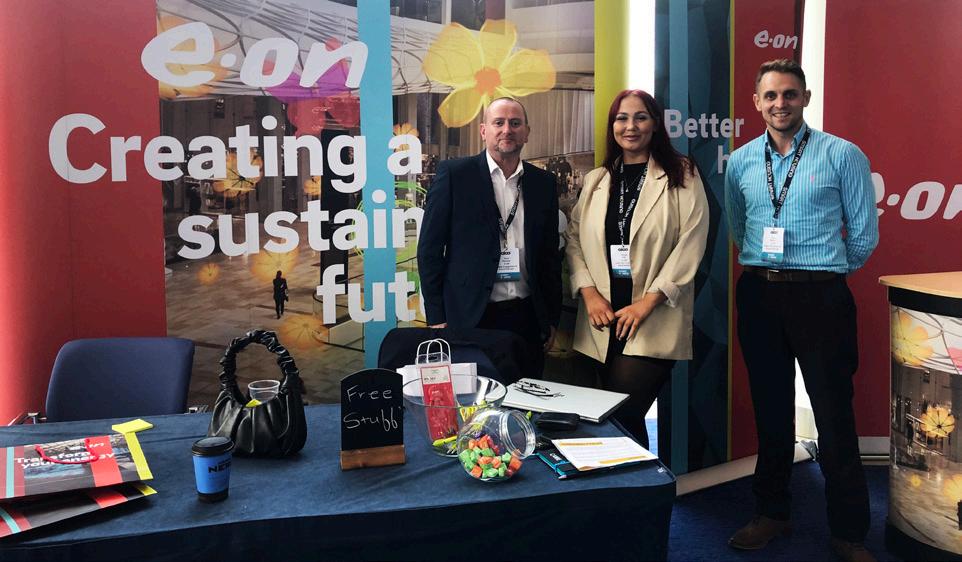

Avoiding The Hyper-Inflation Crisis: a Must Read Procurement Guide
Housing associations need to adapt to inflation at a rapid pace.
As BEIS announced a whole wave of policies to help the housing sector achieve a net zero future, Quadrant Housing explores the requirements for funding and the potential to revolutionise the housing sector.


In this issue, Quadrant Housing analyses how the sector can make the best use of new and existing technology to meet the changing landscape of the housing sector, how a whole systems approach is needed for roofing, and how domestic hydrogen boilers could be mandated by 2026.
With a specific focus on how the social housing sector can expand its housing stock faster, Quadrant Housing dives into the most topical discussions and debates about the future of the housing industry.
quadrant-smart.com
Floyd March f.march@peloton-events.co.uk

Regional Building Hubs: How to Avoid a Boom and Bust
As The Prince’s Foundation ‘Building Towards Net Zero Carbon Homes’ report explored the future of our housing stock, indoor air quality and ambitions to reach net zero, what were the main conclusions and advice for housing associations across the UK?
Beginning the report, Dr Brenda Boardman set out the context of the future of our housing stock and analysed the poignant challenges facing the housing sector. That being how to respond to the climate emergency and how to curb the rapid increase in household fuel bills.
Dr Boardman expressed the notion that: “There is a link between them: the energy inefficiency of our housing stock.”
As a result of the increasing cost of energy, the number of households in fuel poverty was set to have more than doubled by October 2022 over the 2020 level, with fuel bills rising to nearly £3600 this autumn from £1000 two years earlier.
Short and Long-term policy is required to find a solution
The short-term solution is to subsidise daily fuel costs, but the permanent response must be to make their homes more energy efficient, so they need to buy less energy. Dr Boardman went on to explain: “The good news is that the emphasis is gradually switching from installing individual measures to achieving a defined level of energy performance for the whole building, as measured by the energy performance certificate.”
This mentality has changed as multiple energy efficiency improvements are usually required to upgrade properties and achieve a higher band on the EPC. The focus is on getting homes into the
top energy efficiency bands of A-C in order to reduce the risk of fuel poverty and climate change.
The second key issue Dr Boardman described is the climate change imperative. “The built environment is a major consumer of energy for heating, lighting, and appliances. Of the 40% GHG emissions linked to the building sector, only 13% results from the direct use of fossil fuels (mainly gas) in the home, according to the National Housing Federation.”
Getting the message across to private house owners is also a significant bottleneck to improving the existing housing stock. With many individual owners unsure about how to upgrade the energy efficiency of their homes, local authorities have a clear responsibility to get this message across, and the UK government must expand grants to include this demographic.
Skills gap to continue long into the future
For the construction workforce, the challenge is to overcome the focus on the individual skills of particular trades and to provide the solutions for the property to meet the required standard. “It would be helpful for homeowners and the UK’s legal commitments on climate change if the timetable for action on the energy efficiency of all homes was clear and understood,” added Dr Boardman.
Another article within The Prince’s Foundation report took the ideas from Dr Boardman further and pursued a deep dive into the specific problems to build on the holistic approach established above.
The critical aspect of improving this is to focus on indoor air quality in houses and the impacts efficient homes can have on this. Chloe Curtis highlighted that Microbial pollution, including bacteria and fungi from damp and mould, is another crucial factor that impacts indoor air pollution.
Poor Housing costs the NHS millions per year
Chloe explained: “This can develop when there is deficient building maintenance, defects that lead to water ingress, and a lack of effective ventilation, which all result in an increase in moisture. This can have serious implications for health, with a strong link between dampness in buildings, mould growth, and associated respiratory diseases.”
One of the most common contaminants of indoor air is volatile organic compounds (VOCs), which are emitted by materials we use to build and maintain homes. They can be absorbed into the body via the air we breathe and can transfer through our skin.
They can cause headaches, and eye and respiratory irritations and are associated with long-term health effects such as allergies and asthma. “The types of materials used in buildings have increased from roughly 50 to 55,000 over the last century, with only about 3 per cent of these materials having been tested for their toxicity on humans."
Compiled of over six hundred research projects and analyses, there was a detailed examination to explore the effects of fuel poverty; household energy efficiency; indoor air quality; embodied energy, and the ‘hidden’ costs of construction in relation to net zero goals for buildings.
Regional Building Hubs could offer unique solutions to multiple problems
Writing the conclusion in the report, Dr David Howard explored the following questions: “How do we access the evidence, implement the knowledge, and build the capacity to deliver practical net zero homes?”
He went on to explore the idea of Regional Building Hubs and how they emerged from conversations between landowners and builders, supported by the evidence presented in this report.
According to the report, they work as a “pragmatic means to provide employment; to support regional economies; to respond directly to the climate crisis; and to deliver net zero Homes for UK residents.
The Regional Building Hub Housing Manuals Technical Manuals Funding Streams Skills Training
Chloe Curtis The Prince's FoundationOverall the report drew together a broad range of evidence from qualitative and quantitative studies of the built environment to assess the implications of, and possibilities for, achieving a radical, transformative, and necessary shift towards providing net zero homes for urban and rural populations.
This represents thousands of new sources of potential pollutants for harmful indoor air.
Whole Systems Approach to Roofs Can Save Associations Millions in Repairs
With retrofit high on the agenda for housing associations and local authorities looking to improve their existing housing stock while building new affordable homes, more considerations need to be made for improving roofing across the social housing sector.
Taking this a step further, measures should be put in place to ensure roofing solutions are maintenance-free to help save future costs and time savings. The recognition that this needs improvement across the sector is increasing.

Part of this recognition is acknowledging that a roof works as a system rather than a combination of individual parts. The interaction of each piece of roofing should be carefully considered to create a ‘jigsaw’ effect, improving energy efficiency, the life cycle of the products and reducing repair costs and times.
Life cycles of roofs can be dramatically improved
A guaranteed life cycle extension surrounding a roof ‘system’ allows for housing associations to budget accurately and shift funds used for roofing repairs to repair and retrofit other parts of their housing stock.
With the housing sector moving away from traditional reliance on mortar to keep roofing materials in place, mechanical and dry fixing solutions are proving to be a more environmentally friendly and effective way of connecting pieces of the ‘jigsaw’ together. These are generally proprietary systems, requiring their own unique installation methods.
Whole systems approach to roofing will ease budgets constraints for associations
Taking a systems approach to the whole roof means housing associations will have to take a more in-depth analysis of their roofing practices, and understanding the performance characteristics of each system is imperative.
The wide-scale adoption of dry fix systems in the UK would be all for an age of maintenance-free roofing. It is important to highlight this will only be achievable if all parts of the system are reliable and correctly installed across the housing stock of each association.
The forthcoming British Standard for Dry fixed ridge, hip and verge systems – BS 8612 will finally give the industry appropriate standards and specifications for these dry fixed products.
While a wide-scale adoption of a whole system roof approach would be widely accepted, there are core issues around risks for the client whenever newer methods are introduced.
Policy and new frameworks can ease nerves around new construction methods
Suppose new methods aren’t backed by policy and frameworks from the government. In that case, anyone involved in the design-to-build process may be reluctant to introduce new methods of construction if there is no clear line of responsibility.
These concerns could range from roof specifications to whether components have been substituted for non-specified products, all of which are reasonable concerns when so many aspects go into a whole system approach to roofing.
For associations looking to implement a whole roof system, the anatomy generally includes a roofing deck, underlayment, flashing/drip edge, shingles and ventilation.

Why The Housing Sector Needs a Full Audit of Housing Stock
Highlighting seven key recommendations for housing associations to follow, The Better Social Housing Review has published its final report to improve the social housing sector in England.
With the panel first announced in June 2022, the NHF and CIH set up an industryled approach to make recommendations to the government about tackling the quality of homes.

The report comes at a critical time for the social housing sector, as more shocking media reports uncover terrible living conditions across large swathes of the sector. Most notably, the report follows the tragic death of Awaab Ishak, who was found to have died from a respiratory condition caused by prolonged exposure to black mould in a one-bed flat managed by Rochdale Boroughwide Housing.
As part of a six-month review, the panel has considered evidence from various individuals and organisations working in England. Ensuring all aspects of the
sector were considered, organisations involved included tenant groups and campaigners, housing professionals and frontline workers, as well as customerfacing staff.
Seven recommendations come from industry-wide report
After the review process, seven recommendations were made in total, exploring different ways to improve the housing stock and the role the central government plays in implementing better policy and funding avenues.
Firstly, the report highlighted that every housing association, and the sector as a whole, should refocus on their core purpose and deliver against it. In a system under pressure, housing associations need to go back to test their performance against their core purpose – to provide decent, safe homes for those who can’t afford the market.
Expanding on this, it stated: “When housing associations can demonstrate that they are delivering against that purpose, they should then review again what further capacity they have available to continue to deliver against wider responsibilities and ambitions.”
A thorough audit of all housing associations is required
Secondly, and one of the biggest recommendations, housing associations should work together to conduct and publish a thorough audit of social housing in England. As explained in the report: “There is currently no comprehensive, consistently measured picture of the state of social housing across the country. Different housing associations have varying approaches to auditing their stock and expressing data.”
Instead, housing associations should work together to undertake a comprehensive national audit of social housing. The panel recommends that they should do this by adopting and applying the new HACT UK Housing Data Standards right across the sector.
Focussing on collaboration is a growing buzzword in the sector, but implementing a joined up approach is difficult to execute successfully. In an attempt to kickstart this, the report went on to recommend that housing associations should partner with tenants, contractors and frontline staff to develop and apply new standards defining what an excellent maintenance and repairs process looks like.
There are widespread and growing concerns about how too many housing associations manage the maintenance and repair of their housing stock and respond to concerns and complaints about this raised by tenants.
“Each housing association should ask tenants, frontline staff and contractors to work together to review how the organisation deals with maintenance and repairs. They should develop new standards together to be applied to review the organisation’s performance and then develop an annual plan for continuous improvement,” the report added.
Closing the skills gap is non-negotiable
With CIH leading on the report, they acknowledged that housing associations need further guidance at different steps of retrofit and for unique challenges per association. With this in mind, The Chartered Institute of Housing should promote the traditional housing officer4 role as a supported and valued employment opportunity with a Chartered Institute of Housing recognised programme of training and continuing development.
Exceptional pressures and demands on frontline staff working directly with tenants are contributing to very high turnover rates at this level and making it harder for many tenants to communicate with their landlords.
More support and training opportunities from leading professionals could curb the high turnover rate and reduce the skills gap across all aspects of the sector. In order to do this, housing associations should increase investment in recruiting, developing and supporting the retention of more housing officers to enable them to re-establish more manageable patch sizes.
Social value should be at the heart of every decision
The remaining recommendation is intertwined with social value and how to have social value at the heart of every decision made by associations.
Breaking the recommendations down further: “Housing associations should work with all tenants to ensure that they have a voice and influence at every level of decision making across the organisation, through both voluntary and paid roles; develop a proactive local community presence through community hubs which foster greater multi-agency working and should support tenants and frontline staff to undertake an annual review of the progress each organisation is making in implementing this review’s recommendations.”
Avoiding the Hyperinflation Crisis: A Must Read Procurement Guide
Housing associations across the UK have been advised to read new procurement guidance to help mitigate the ‘hyper-inflation’ crisis happening across the UK.
With inflation hitting the highest level in 40 years, the 11.1 per cent increase has been fuelled by rising energy costs and, specific to the housing sector, difficulties in the supply chain. Creating further bottlenecks to the housebuilding sector, the landscape for procuring in construction is under sustained threat.
In the recent Autumn statement, there was little offering in mitigating these rising costs in the housing sector, in turn creating a sense of unease across the market.
Supplementary material to guide associations and authorities
Updating the Beter Procurement for Better Homes Guide, The Housing Forum has released supplementary information in order to guide the housing sector through uncertain times and cope with core inflationary challenges.
While focusing on local authorities and housing associations, many contractors, builders, and consultants can take a private sector perspective from the guidance. Aligning the public and private sector’s ambitious challenges and opportunities will be at the heart of continuing the development of housing in the next few years.
Key messages in the guidance:
It’s important to build trust – Working with contractors who share values of commitment to quality, are willing to work in an open book environment and demonstrate a collaborative approach reduces risk.
Closely involve the finance and procurement teams – Whole-team decision-making needs to be a dynamic process, with budget holders updated and alerted as soon as inflation looks to add cost pressures that threaten to breach contingencies. Manage risks equitably between commissioner and contractor –acknowledging that some price fluctuation (both up and down) will have to be accommodated over long contracts.
Engage early with the contractor’s supply chain – enabling quicker decision-making via an open book approach.
Use flexible contracting – with an emphasis on how pre-contract agreements can be managed and that can start to lock in cost early, where possible. Single-stage, fixedprice design and build contracting in the current hyperinflationary market becomes even less workable.
Breaking this down in further detail, the guidance highlighted the importance of following four steps to navigating project stages in more detail successfully. The steps include Holding onto the project vision, Establishing the right team for good decision making, Designing with value in mind, and Appointing the contractor/supply chain.
Four focusses for a successful procurement strategy

Focussing on the importance of keeping hold of the project vision, the report explained: “A statement of vision or intent is the foundation of good procurement and provides the opportunity for the client to capture all that is important about the project in a high-level way as a reference throughout its conception, delivery and management.”
When exploring the importance of picking the right team to oversee project delivery, it often goes unnoticed how this is a vital step to good procurement for housing associations and local authorities.
The guidance added: “Decision makers need to be on-board and engaged in the project, and team continuity encouraged. Again, it is important to have the right individuals on the team, but this is particularly difficult in a buoyant market where good people are in demand. The emphasis must be on bringing individuals through who are properly trained and given the right experience and opportunities.”
Authorities must plan and design with value in mind
Designing with value in mind can help keep down costs without compromising on design or quality. “This means keeping things simple by minimising and standardising the number of different components. For example, choosing one window design rather than several different designs. Stacking dwelling types and/or bathrooms so the building’s structure and services are efficient, is another example of designing with value in mind.”
The main principles set out in Better Procurement for Better Homes of appointing main contractors and the supply chain early are even more critical in a hyperinflationary market. Appointing the contractor at the earliest opportunity (potentially at the pre-planning stage) under a flexible partnering contract, or using a PCSA, is vital to manage design and risk and optimise the use of MMC.
If these steps are followed, The Housing Forum concluded: “Clients can aim to reduce the time from appointment to start on site by appointing contractors from frameworks. Firms on these frameworks
Catalyst to Make Best use of Brownfield Land In London
Utilising brownfield land will help increase housebuilding across the UK, especially in the urban areas where greenbelt land is proving to be restrictive.
Leading the industry, housebuilders Catalyst and Hill have been granted permission to plan for a 995-home mixed use scheme on a former hospital site in North London.
With plans approved by Haringey Council in early December 2022, the new buildings range in height from three to nine storeys on a 7.2-hectare plot that was previously part of St Ann’s Hospital.
Brownfield land should be dedicated for affordable housing
60% of the housing will be allocated as affordable, and the rest of the allocation for market sale. Breaking this down further, 54% will be offered at London Affordable Rent and 46% as intermediate housing, which includes shared ownership, according to the planning application.
As the demographics of people requiring affordable housing are changing, housebuilders are required to build with these needs in mind.
Acknowledging these requirements, nearly a fifth of the homes (168) will have three or more bedrooms, which means they will be deemed suitable for families.
Catalyst, which has been a subsidiary of Peabody since April this year, was selected by the mayor of London to develop the site.
Focussing on non-residential buildings, seven of the disused hospital buildings have been retained for workspaces, shops and amenities. With an additional focus on sustainability, new cycle routes will be implemented as part of the proposals.
NIMBY
mentality must be changed, but only high quality housing will do this
In a public consultation, the proposals received 393 responses from local groups and neighbours. Only four comments were supportive, with 389 objecting or commenting, according to council documents.
Some concerns from members of the public included overdevelopment, ‘excessive’ building height, and increased noise pollution.
Building in phases, the first will include 239 homes, with the other allocation to be split into future phases. Talking about the plans, Tom Copley, London’s deputy mayor for housing and residential development, said: “I’m delighted that nearly 1,000 new homes will be delivered on the St Ann’s New Neighbourhood site, 60% of which will be genuinely affordable.”
Determined to be disruptors in the housebuilding market despite the scrapping of 300,000 new homes per year from central government, Catalyst has won approval for two projects in London in the space of six weeks after it received permission for a 1,228-home regeneration scheme in West London.
Good quality housing can keep young people in local areas and boost economies
Making the best use of brownfield land is at the heart of increasing the housing stock available and is one of the biggest opportunities to ease the housing crisis and upgrade the surrounding areas, tying in the levelling up agenda currently set out by the central government.
Rural developments offers the opportunity for young people to find housing and work closer to their local areas and reduce the migration from rural to urban areas for better opportunities.
industry leading access systems


Complete cloud solutions that simplify access control and site management for all users.
Project development support
Free project assistance, from system design to contractor support during installation.
system Bespoking
Tailored system design to deliver client led quality access control solutions



Expert technical support
Our UK based technical team are readily available to offer remote support.


Manufacturer Diagnostic visits
Mobile service teams available to visit site and ensure system reliabilty is optimised.
do you want to work with the leading access control provider in the industry?
We want to work with you. Our experience is vast, our products are quality and our service is second to none. See for yourself. Work with us on your next project.
The Retrofit Conundrum: The Role of Banks in Energy Efficient Investments
Aligning public and private funding is one of the hottest topics in the housing sector, with increased calls for incentivisation from the government and unlocking barriers to financing in the private sector.
Earlier this month, Bankers for NetZero and WPI Economics released the retrofit conundrum report, sponsored by HSBC. It set out core recommendations for the government to support the financing of energy efficient retrofits for UK homes.
According to the report, a potential new policy framework, including propertylinked finance and stamp duty-based incentives, would encourage private investors to enter the market.
In response to the recent ECO+ scheme announced by the government, which offers grants to households in council tax bands A to D for loft and cavity wall insulation, the report explored more comprehensive measures required.
Ian Stuart, Chief Executive of HSBC UK said banks could play: “A critical role in the supply of finance for retrofit, but that it requires a holistic approach, tied to key moments like home improvements and moving house.”
He added: “Beyond financial incentives, there is a need for skilled expertise as well as consumer education and advice about the right choices, guarantees of good works, and improvements to EPC ratings.”
Property-linked finance could unpick current issues
Focussing on property-linked finance could help address payback issues where payback periods are longer than likely tenancies. Additionally, stamp duty discounts for households that will use the money saved to insulate their homes could further incentivise private retrofit.
After addressing the public sector's role in encouraging the private markets, the authors of the report spent time highlighting the role of banking in the retrofit conundrum. They found that banks have an important role to play in helping the UK reach net zero, particularly through the decarbonisation of the domestic building stock, provided the key policy drivers to facilitate this are in place.
As banks develop and release their transition plans, setting out their approach to meeting the Net Zero Banking Alliance Commitment, a key consideration will be the steps needed to reduce emissions associated with key exposures, such as the building stock.
Meaningful policy creates lasting change
The report pondered: “If we are to be successful in reducing not just banks’ Scope 3 emissions, but the emissions of the UK as a whole, it is essential to deliver these targets through meaningful decarbonisation of the building stock across the board.”
In order to do this, the Bankers for NetZero feel: “A policy framework to support building decarbonisation is therefore imperative to support banks in meeting the targets they have set out. It is the overwhelming view of stakeholders we spoke to for this report that the lack of policy in place to support retrofit is the largest barrier to meeting emissions targets.”
It has been widely discussed throughout the industry that the added value of a bank's appropriate access to finance can be an enabler of domestic retrofit with the right policy and wider environment.
Private Landlords not incentivised to self-fund
retrofit
High upfront capital costs and slow rates of recovering the costs through savings on energy bills make it a daunting undertaking, and this would prevent many property owners from retrofitting.
This is where banks have a pivotal role, as they have vast experience in long-term property loans and mortgages.
On the opportunity side, housing finance is the largest segment of retail banking, thus providing a wide platform for driving decarbonisation across the mass market of banking customers.
Ian Stuart Chief Executive HSBCHowever, a sole emphasis on lending or mortgage financing is not an effective way to resolve the broad societal issues that surround decarbonisation. This is not least due to the fact that: “Around 35% of homes in the UK are owner occupied and mortgage free, and that landlords are usually unable to recoup investments they make in properties through a reduction in bills.”
Furthermore, green finance to support retrofit is a rapidly evolving space for regulators such as the Financial Conduct Authority and Prudential Regulation Authority, requiring them to adapt their approach on an ongoing basis.
Key emerging regulatory frameworks, including those around consumer duty and ensuring adequate capitalisation for climate risks, require effective engagement between banks and their relevant regulators to ensure the delivery of decarbonisation strategies.

What can banks do?
Create products, tools and guidance that support householder retrofit.
Increase collaboration with other organisations and civil society organisations to further the retrofit agenda and devise innovative methods for mobilising finance for retrofit.
Integrate net-zero targets, climate change effects and energy efficiency into the considerations for mortgages and other housing finance.
Introduce green bonds at a larger scale catered to specific activities, such as retrofit, by partnering with local authorities.
Create local place-based relationships in cities and regions to pilot financial innovations to support decarbonisation and bring down the cost long-term.
Could we See a Domestic Hydrogen Boiler Mandate by 2026?
price parity with existing gas boilers if deployed market-wide, and assuming that a single market-wide definition can be agreed,” the document said.
A call for evidence approach will future-proof hydrogen in housing
I
n a huge twist in the housing net zero agenda, the government is heavily considering mandating all domestic boilers to be hydrogen ready by 2026. This comes on the back of the summary of responses to the BEIS call for evidence.
BEIS announced these plans alongside a financial package for over £100m for hydrogen and nuclear projects, setting out a clear vision of the role hydrogen can play on the road to net zero in the housing sector.
Additionally, BEIS has recently allocated £77m to support nuclear fuel production and next-generation advanced nuclear reactors in the UK and a further £25m for new technologies that will generate clean hydrogen from biomass and waste.
Support packages to introduce hydrogen into the housing sector to be made available
The benefit of such hydrogen-ready boilers is they can burn natural gas while hydrogen production capacity is increased and can easily be converted and retrofitted as hydrogen blends increase in the future.
In the consultation document launched in December 2022, the government argues that there is a “strong case” for the introduction of hydrogen-ready boilers as standard from 2026.
Guarding against a boom and bust for hydrogen boilers, the consultation clearly outlined that the success of hydrogen boilers rests on the ability that: “These boilers can meet all relevant regulatory standards, that they can reach
The CfE followed the publication of the UK Hydrogen Strategy on 17 August 2021. In the Strategy, the government committed to running a CfE on hydrogenready industrial equipment by the end of 2022. The published CfE focussed on industrial boilers due to their widespread use and because BEIS analysis indicates a significant proportion of the demand for hydrogen in the industry will come from this equipment category.
Furthermore, the technology required for hydrogen boilers is relatively advanced and more standardised than for other types of industrial equipment. For these reasons, industrial boiler equipment presents a good test case for hydrogenready industrial equipment more broadly.
The CfE contained the following three sections:
• The opportunity for hydrogen-ready industrial boilers
• The role of government in supporting hydrogen-ready industrial boiler equipment
• The role of the supply chain and economic opportunities for the UK
However, it warned that at this stage, there is “no guarantee” that any hydrogen-ready boilers will ultimately be converted to run on hydrogen gas.
Introducing a price promise for hydrogen boilers to cost no more than natural gas, there are strong hopes for public approval for future projects.
Mike Foster, chief executive of the Energy and Utilities Alliance and the Heating & Hotwater Industry Council, said a mandate is an “important step towards decarbonising homes.”
He said: “The government are absolutely right to support this no-regrets option. Boiler manufacturers have already made their ‘price promise’ so that a new hydrogen-ready boiler will cost the same as a natural gas appliance.
“So this means 1.7 million homes a year will be ready for net zero at no extra cost to the consumer, helping us hit our 2050 target.”
Other countries across Europe are betting big on green hydrogen Energy Minister Lord Callanan said: “With its potential to go one step further than net zero and be carbon negative – removing greenhouse gas emissions from the atmosphere – this hydrogen technology will be crucial to achieving our climate goals.
Other countries across Europe are also looking into the feasibility of hydrogen boilers for domestic use. The Netherlands, for example, is using a local grid that has been converted to pipe hydrogen instead of natural gas. The three-year experiment is being run by local operator Alliander using BDR Thermea hydrogen boilers.

Our £25m government funding to develop this technology will help unlock private investment and generate new green jobs – all while cutting carbon emissions.
Lord Callanan Energy Minister
How is Yorkshire Delivering for its Residents?
Building on the success of Smart Housing North West, Quadrant Smart will be coming to Leeds on 21 February 2023 to discuss the core issues and opportunities in the area.
As Yorkshire covers a vast area, including rural, suburban and urban areas, the region has a range of challenges to overcome in the housing sector. These range from net zero, retrofitting, improving cyber security and promoting regional innovation.
To tackle these objectives, Leeds City Council launched its Housing Strategy 2022-27, named Best City Ambition. Offering a whole range of opportunities, the strategy includes plans to deliver 928 mixed-tenure homes starting with an initial 311 energy-efficient affordable homes. This will build on the 54,000 council-owned dwellings currently in Leeds.
Deliverability is a core aspect of Leeds’ strategy
Responsible for roughly 2.2 per cent of England’s housing supply in 2021, Leeds has delivered 16,249 homes over the last five years. The strategy hopes to expand on these deliverability statistics and offer a framework for smaller authorities to implement similar projects.

The strategy also highlights the essential factor that the housing sector contributed roughly 27 per cent of CO 2 emissions in Leeds between 2019-20. The housing sector is critical in supporting the city’s net zero ambitions through this strategy.
Exploring the target outcomes of the strategy, it was announced that the authority hopes to deliver 800 new affordable homes per year over the next three years up to and including 2025.
Social value is just as important to focus on as building
Focussing on social values, Leeds City Council hopes to maximise the number of high-priority customers rehoused through the Leeds Homes Register and increase the number of customers currently on the Homes Register rehoused to the private sector.
While focusing on the transition of people into different tenure homes, another target outcome is to reduce the number of long-term empty homes in the city. The best way to reduce the impacts of the housing crisis is to make the most of the existing housing stock across the region.
Retrofitting existing stock is high on the agenda in Leeds, with a costed policy to retrofit council housing by 2025, which involves £100m to be spent across the city. All buildings must meet the 2022 Building Safety Act protecting residents and avoiding another Grenfell-scale disaster. Additionally, Leeds is looking to maximise positive outcomes through the selective licensing scheme and improve SAP ratings to an average of C as soon as possible.
In Case you Missed it NORTH WEST
If you missed the Manchester event, then make sure you look at the highlight reel, which showcases the key events of the day and hear from our exhibitors and attendees. Here is a breakdown of the Smart Housing North West highlight reel where we heard from Cllr Gavin White from Manchester City Council, hosted panel debates and heard a range of presentations from industry leaders.
Exploring what just a few of our exhibitors had to say about innovating the sector, they had these clear messages for the housing industry.

Continuing our regionally focussed events in Yorkshire on 21 February 2023, you can secure your place as an exhibitor, headline sponsor or speaker today. See the next page for further details.


Creating Sustainable Homes for the Future
21 February, 2023 Royal Armouries Museum, Leeds
Why Smart Housing?
Housing is an integral part of the evolution of the Smart City. Never has it been more important to create sustainable urban areas which are designed for the future, whether that be retrofitting existing homes, achieving net zero carbon emissions, to smart placemaking.
By utilising the Smart Housing mindset, the entire housing sector can come together to deliver the urgent need for more sustainable homes, designed for future generations to live and work together.
Join us on 21 February 2023 at The Royal Armouries, Leeds , where housing leaders, experts and innovators will be discussing what is needed right now to drive meaningful change and create communities for the future.

Join the conversation #SmartHousing

